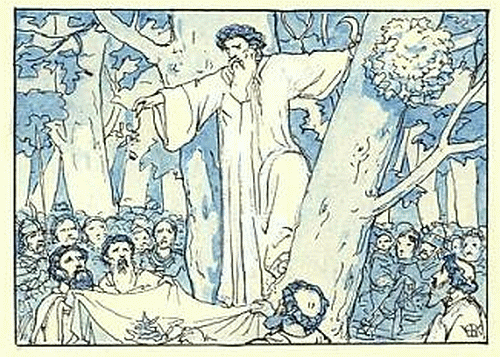We all know mistletoe as the twig we hang in doorways and thresholds during the Christmas or Yuletide season and under which we kiss. But why? Where did this tradition come from and why is this parasitic and poisonous plant at the center of it?

Mistletoe has a history that dates back thousands of years. Many ancient cultures prized mistletoe for its healing properties. The Greeks used it as a cure for everything from menstrual cramps to spleen disorders, and the Roman naturalist Pliny the Elder used it as a balm against epilepsy, ulcers, and poisons.
In Greece, it is thought of as the “Golden Bough.” Aeneas, a survivor of Troy, settled in Italy and founded the community that was to become the Roman Empire. In one of his many adventures, he searched for his dead father Anchises and found him in the land of the dead. To get there, he was told that he must first seek and pluck the “golden bough” from a tree in the forest. Doves sent by Venus, his mother and the goddess of love, sex, beauty, and fertility, led him to the golden bough, which he used to successfully visit his father and return to the land of the living. This golden bough is assumed by many writers and scholars to be mistletoe because it often appears golden in the winter months.

The Celts also believed the plant to be associated with love and sexuality. According to the Symbol Dictionary, the Celts associated mistletoe with the solar diety Taranis because of its golden color and the way it grows high off the ground without roots. Because mistletoe blossoms even during the winter, the Druids came to view it as a sacred symbol of vivacity, and they administered it to humans and animals alike in the hope of restoring fertility. They also saw its waxy white berries as a promise of the return of the sun.
Interestingly, in Old Norse tradition, mistletoe is also associated with the sun god, but in a different, more sinister way.

Baldur, the most beloved of all the gods and the son of Odin, began to have nightmares of some grave misfortune about to befall him. Fearing for his son, Odin rode to the underworld to consult a dead seeress who was wise in such matters. When he arrived in the underworld, he found the halls decorated, as if for a feast. The seeress told Odin that the feast was for his son Baldur. In a panic, Odin returned to his home in Asgard and told his household what he had seen. Hearing this, Frigg, Baldur’s mother, went to everything in the cosmos, both living and nonliving, and obtained oaths to not harm Baldur.
When she returned, the mischievous Loki went to Frigg and asked whether all things has sworn an oath, to which Frigg told him, everything but the small and innocent mistletoe. Upon hearing that, Loki found a mistletoe, carved a spear from it, handed it to the blind god Hodr, and told him to throw it at Baldur. The mistletoe pierced Baldur, who fell dead.

The Old Norse believed Frigg would resurrect her son when her tears stained the berries of the mistletoe white. She also decreed that, instead of being punished, mistletoe should become a symbol of peace and friendship evermore.
In medieval times, the plant was called allheal because of its medicinal properties. Sprigs were hung in stables to protect livestock from the mischief of fairies. An old English superstition held that as long as a sprig hung in a home, love would stay present, a carry-over perhaps of both the ancient druidic and Norse beliefs, and probably where the origin of the kissing ritual can be found.
According to Historian Mark Forsyth, however, the earliest reference of kissing under the mistletoe doesn’t appear until 1784. The reference appeared in a verse that read,
“What all the men, Jem, John, and Joe,
Cry, ‘What good-luck has sent ye?’
And kiss beneath the mistletoe,
The girl not turn’d of twenty.”
Other historians have also cited these lines as the first reference of the tradition. But what happened to make kissing under the mistletoe a holiday phenomenon remains unknown. “I can take a pretty shrewd guess that it involved a particularly lusty and inventive boy, and a particularly gullible girl,” Forsyth writes in his book A Christmas Cornucopia: The Hidden Stories Behind Our Yuletide Traditions.
I hope you’ve enjoyed the read.
Sign Up
Sign up to have new blog posts and other free content delivered to you monthly!





